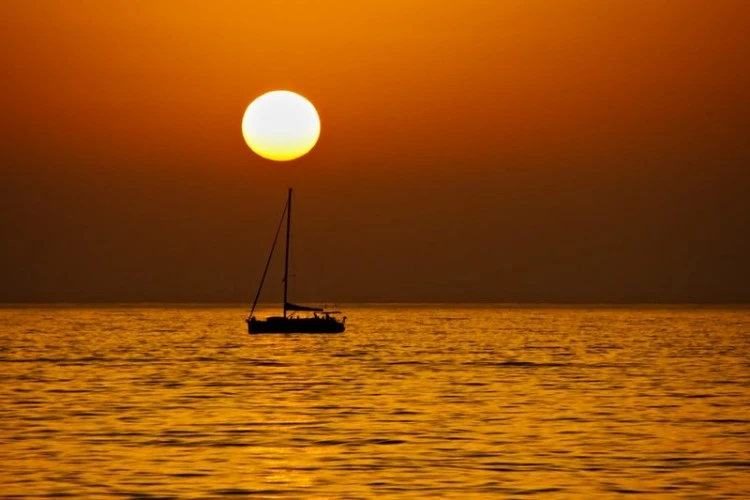
The Aeolian Islands, also known as the Lipari Islands, form an archipelago located to the north of Sicily in the Tyrrhenian Sea. The islands are volcanic and are home to Stromboli and Vulcano, both active volcanoes. The archipelago is made up of seven islands; Lipari, Salina, Vulcano, Stromboli, Filicudi, Alicudi and Panarea. The name derives from Aeolus, the god of wind, who according to Greek mythology, found shelter on the Aeolian Islands. It is said that he lived on the island of Lipari and was able to predict the weather for the inhabitants of the island, which was important for the fishermen. Aeolus gained great popularity in the islands, so much so that they named the islands after him.
The Aeolian Islands have been inhabited since ancient times and due to the presence of pumice stone and obsidian, a type of volcanic glass, the islands became important on the trade routes. During the Greek period, this archipelago represented an important crossroads and meeting place for Phoenicians, Greeks and Etruscans. The islands have been ruled and conquered by various populations, including Arabs, Spaniards and Normans. In 2000 the archipelago was declared a UNESCO World Heritage Site, as a biosphere reserve.
Places to visit
The Regional Archaeological Museum is located in Lipari, and house objects and artefacts from populations who inhabited the islands as far back as the prehistoric age up to the Middle Ages. The coasts of Lipari are mostly high and rocky and do not offer many bays or coves. But one of the most beautiful beaches is Pollara in Salina, where many scenes from the film The Postino were shot. The beach has a breathtaking view during the sunset. The island is also known for its black sand beaches, where the tiny lava stones look like little crystals when the sun shines on them. There is also great flora and fauna to see, for example in Lipari you can find heather, oleander, myrtle and rosemary which perfume the whole island. The caper tree is a symbol of the islands and pink heather blooms until late summer, purple or white hibiscus peeps from the gardens of villas in an explosion of colour. The Bougainvillea, a plant imported into Europe by the French explorer De Bouganville, grows on walls of the villas, cascading with colour.
Discover with us how to reach and what to visit in Aeolian Islands: curiosities, events, local festivals, traditional recipes and all the other details to discover Aeolian Islands from our blog!
SIREMAR
2 weekly sailings
11 h 15 min
SIREMAR
2 weekly sailings
12 h 05 min
SIREMAR
2 weekly sailings
14 h 15 min
SIREMAR
2 weekly sailings
13 h 15 min
SIREMAR
2 weekly sailings
10 h 30 min
SIREMAR
2 weekly sailings
15 h 10 min
SNAV
5 weekly sailings
5 h 05 min
SNAV
5 weekly sailings
5 h 35 min
SNAV
5 weekly sailings
4 h 30 min
SNAV
5 weekly sailings
6 h 10 min
SNAV
5 weekly sailings
6 h 30 min
LIBERTY LINES
21 weekly sailings
1 h 30 min
LIBERTY LINES
7 weekly sailings
3 h 45 min
LIBERTY LINES
21 weekly sailings
2 h 20 min
LIBERTY LINES
7 weekly sailings
3 h 10 min
LIBERTY LINES
7 weekly sailings
2 h 15 min
LIBERTY LINES
21 weekly sailings
1 h 45 min
LIBERTY LINES
2 weekly sailings
3 h 10 min
LIBERTY LINES
2 weekly sailings
3 h 30 min
LIBERTY LINES
2 weekly sailings
2 h 05 min
LIBERTY LINES
2 weekly sailings
1 h 30 min
LIBERTY LINES
2 weekly sailings
2 h 40 min
LIBERTY LINES
7 weekly sailings
4 h
SIREMAR
5 weekly sailings
3 h 35 min
LIBERTY LINES
24 weekly sailings
1 h 45 min
SIREMAR
5 weekly sailings
2 h
LIBERTY LINES
24 weekly sailings
55 min
LIBERTY LINES
14 weekly sailings
1 h 10 min
LIBERTY LINES
7 weekly sailings
3 h 10 min
SIREMAR
5 weekly sailings
3 h
LIBERTY LINES
24 weekly sailings
1 h 25 min
SIREMAR
5 weekly sailings
55 min
LIBERTY LINES
24 weekly sailings
25 min
LIBERTY LINES
7 weekly sailings
3 h 45 min
SIREMAR
5 weekly sailings
55 min
LIBERTY LINES
21 weekly sailings
25 min
LIBERTY LINES
7 weekly sailings
3 h 15 min
SIREMAR
5 weekly sailings
55 min
LIBERTY LINES
24 weekly sailings
25 min
LIBERTY LINES
14 weekly sailings
40 min
SIREMAR
5 weekly sailings
2 h 30 min
LIBERTY LINES
24 weekly sailings
1 h 15 min
LIBERTY LINES
7 weekly sailings
3 h 30 min
SIREMAR
5 weekly sailings
1 h 55 min
LIBERTY LINES
24 weekly sailings
55 min
LIBERTY LINES
7 weekly sailings
2 h 40 min
SIREMAR
5 weekly sailings
2 h 45 min
LIBERTY LINES
33 weekly sailings
55 min
SIREMAR
5 weekly sailings
45 min
LIBERTY LINES
33 weekly sailings
25 min
SIREMAR
5 weekly sailings
1 h 45 min
LIBERTY LINES
11 weekly sailings
55 min
SIREMAR
5 weekly sailings
20 min
LIBERTY LINES
28 weekly sailings
10 min
SIREMAR
5 weekly sailings
3 h 20 min
LIBERTY LINES
27 weekly sailings
1 h 10 min
SIREMAR
5 weekly sailings
3 h 10 min
LIBERTY LINES
24 weekly sailings
1 h
SIREMAR
5 weekly sailings
2 h 50 min
LIBERTY LINES
33 weekly sailings
55 min
SIREMAR
5 weekly sailings
2 h 05 min
LIBERTY LINES
24 weekly sailings
1 h 05 min
SIREMAR
5 weekly sailings
3 h 15 min
LIBERTY LINES
47 weekly sailings
1 h
SIREMAR
29 weekly sailings
20 min
LIBERTY LINES
134 weekly sailings
10 min
SIREMAR
13 weekly sailings
50 min
LIBERTY LINES
77 weekly sailings
25 min
SIREMAR
25 weekly sailings
49 min
LIBERTY LINES
113 weekly sailings
20 min
SIREMAR
5 weekly sailings
1 h 55 min
LIBERTY LINES
47 weekly sailings
25 min
SIREMAR
5 weekly sailings
1 h 10 min
LIBERTY LINES
47 weekly sailings
25 min
LIBERTY LINES
7 weekly sailings
45 min
SIREMAR
6 weekly sailings
50 min
LIBERTY LINES
21 weekly sailings
25 min
SIREMAR
6 weekly sailings
2 h 25 min
LIBERTY LINES
40 weekly sailings
40 min
SIREMAR
6 weekly sailings
1 h 50 min
LIBERTY LINES
54 weekly sailings
25 min
SIREMAR
5 weekly sailings
40 min
LIBERTY LINES
33 weekly sailings
25 min
SIREMAR
11 weekly sailings
1 h 25 min
LIBERTY LINES
81 weekly sailings
45 min
SIREMAR
2 weekly sailings
1 h 10 min
LIBERTY LINES
14 weekly sailings
1 h 50 min
SIREMAR
11 weekly sailings
50 min
LIBERTY LINES
88 weekly sailings
25 min
SIREMAR
6 weekly sailings
25 min
LIBERTY LINES
59 weekly sailings
10 min
SIREMAR
2 weekly sailings
2 h 10 min
LIBERTY LINES
21 weekly sailings
55 min
SIREMAR
2 weekly sailings
2 h 10 min
LIBERTY LINES
7 weekly sailings
2 h 45 min
SIREMAR
2 weekly sailings
1 h 05 min
LIBERTY LINES
21 weekly sailings
25 min
SIREMAR
2 weekly sailings
2 h 45 min
LIBERTY LINES
14 weekly sailings
2 h 25 min
SIREMAR
3 weekly sailings
1 h 10 min
LIBERTY LINES
21 weekly sailings
40 min
SIREMAR
3 weekly sailings
1 h 45 min
LIBERTY LINES
26 weekly sailings
55 min
SIREMAR
3 weekly sailings
2 h 15 min
LIBERTY LINES
21 weekly sailings
1 h 10 min
SIREMAR
3 weekly sailings
50 min
LIBERTY LINES
40 weekly sailings
25 min
SIREMAR
23 weekly sailings
49 min
LIBERTY LINES
94 weekly sailings
20 min
SIREMAR
3 weekly sailings
2 h 10 min
LIBERTY LINES
40 weekly sailings
1 h
SIREMAR
3 weekly sailings
5 h 10 min
LIBERTY LINES
57 weekly sailings
10 min
SIREMAR
23 weekly sailings
1 h 24 min
LIBERTY LINES
91 weekly sailings
40 min
LIBERTY LINES
7 weekly sailings
1 h 15 min
SIREMAR
6 weekly sailings
2 h 15 min
LIBERTY LINES
21 weekly sailings
1 h
SIREMAR
6 weekly sailings
3 h 50 min
LIBERTY LINES
40 weekly sailings
1 h 10 min
SIREMAR
4 weekly sailings
25 min
LIBERTY LINES
26 weekly sailings
10 min
SIREMAR
6 weekly sailings
3 h 15 min
LIBERTY LINES
54 weekly sailings
55 min
SIREMAR
6 weekly sailings
1 h 10 min
LIBERTY LINES
54 weekly sailings
25 min
SIREMAR
5 weekly sailings
2 h 30 min
LIBERTY LINES
47 weekly sailings
50 min
SIREMAR
32 weekly sailings
20 min
LIBERTY LINES
124 weekly sailings
10 min
SIREMAR
5 weekly sailings
3 h 50 min
LIBERTY LINES
47 weekly sailings
1 h 20 min
SIREMAR
5 weekly sailings
2 h 45 min
LIBERTY LINES
21 weekly sailings
1 h 25 min
SIREMAR
5 weekly sailings
3 h 25 min
LIBERTY LINES
26 weekly sailings
1 h 30 min
SIREMAR
5 weekly sailings
3 h 50 min
LIBERTY LINES
21 weekly sailings
1 h 55 min
SIREMAR
25 weekly sailings
1 h 24 min
LIBERTY LINES
106 weekly sailings
40 min
SIREMAR
13 weekly sailings
1 h 25 min
LIBERTY LINES
64 weekly sailings
40 min
LIBERTY LINES
35 weekly sailings
2 h 25 min
LIBERTY LINES
21 weekly sailings
1 h 50 min
LIBERTY LINES
28 weekly sailings
3 h
LIBERTY LINES
21 weekly sailings
2 h 10 min
LIBERTY LINES
14 weekly sailings
2 h 55 min
LIBERTY LINES
21 weekly sailings
2 h 25 min
SIREMAR
30 weekly sailings
1 h 30 min
LIBERTY LINES
103 weekly sailings
45 min
SIREMAR
5 weekly sailings
5 h 30 min
LIBERTY LINES
57 weekly sailings
1 h 10 min
SIREMAR
20 weekly sailings
3 h 10 min
LIBERTY LINES
92 weekly sailings
1 h 25 min
SIREMAR
30 weekly sailings
2 h
LIBERTY LINES
113 weekly sailings
50 min
SIREMAR
5 weekly sailings
5 h 05 min
LIBERTY LINES
43 weekly sailings
1 h 25 min
SIREMAR
5 weekly sailings
4 h 30 min
LIBERTY LINES
21 weekly sailings
2 h 20 min
SIREMAR
5 weekly sailings
5 h 35 min
LIBERTY LINES
21 weekly sailings
2 h 50 min
SIREMAR
13 weekly sailings
3 h 10 min
LIBERTY LINES
58 weekly sailings
1 h 40 min
SIREMAR
5 weekly sailings
4 h 10 min
LIBERTY LINES
57 weekly sailings
1 h 25 min
LIBERTY LINES
7 weekly sailings
6 h 05 min
LIBERTY LINES
7 weekly sailings
3 h 15 min
LIBERTY LINES
7 weekly sailings
3 h
LIBERTY LINES
7 weekly sailings
5 h 15 min
LIBERTY LINES
7 weekly sailings
3 h 45 min
LIBERTY LINES
7 weekly sailings
5 h 50 min
LIBERTY LINES
7 weekly sailings
4 h
LIBERTY LINES
7 weekly sailings
2 h 30 min
LIBERTY LINES
7 weekly sailings
2 h


